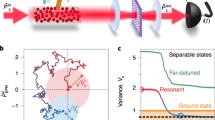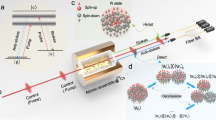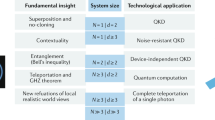Abstract
Entanglement is considered to be one of the most profound features of quantum mechanics1,2. An entangled state of a system consisting of two subsystems cannot be described as a product of the quantum states of the two subsystems3,4,5,6. In this sense, the entangled system is considered inseparable and non-local. It is generally believed that entanglement is usually manifest in systems consisting of a small number of microscopic particles. Here we demonstrate experimentally the entanglement of two macroscopic objects, each consisting of a caesium gas sample containing about 1012 atoms. Entanglement is generated via interaction of the samples with a pulse of light, which performs a non-local Bell measurement on the collective spins of the samples7. The entangled spin-state can be maintained for 0.5 milliseconds. Besides being of fundamental interest, we expect the robust and long-lived entanglement of material objects demonstrated here to be useful in quantum information processing, including teleportation8,9,10 of quantum states of matter and quantum memory.
This is a preview of subscription content, access via your institution
Access options
Subscribe to this journal
Receive 51 print issues and online access
$199.00 per year
only $3.90 per issue
Buy this article
- Purchase on Springer Link
- Instant access to full article PDF
Prices may be subject to local taxes which are calculated during checkout



Similar content being viewed by others
References
Einstein, A., Podoslky, B. & Rosen, N. Can quantum-mechanical description of physical reality be considered complete? Phys. Rev. 47, 777–780 (1935).
Bell, J. S. Speakable and Unspeakable in Quantum Mechanics (Cambridge Univ. Press, Cambridge, 1988).
Aspect, A., Dalibard, J. & Roger, G. Experimental test of Bell's inequalities using time-varying analyzers. Phys. Rev. Lett. 49, 1804–1807 (1982).
Togerson, J. R., Branning, D., Monken, C. H. & Mandel, L. Experimental demonstration of the violation of local realism without Bell inequalities. Phys. Lett. A 204, 323–328 (1995).
Duan, Lu. M., Giedke, G., Cirac, J. I. & Zoller, P. Inseparability criterion for continuous variable systems. Phys. Rev. Lett. 84, 2722–2725 (2000).
Simon, R. Peres-Horodecki separability criterion for continuous variable systems. Phys. Rev. Lett. 84, 2726–2729 (2000).
Duan, L. M., Cirac, J. I., Zoller, P. & Polzik, E. S. Phys. Rev. Lett. 85, 5643–5646 (2000).
Bouwmeester, D., Pan, J. W., Mattle, K., Eibl, M., Weinfurter, H. & Zeilinger, A. Experimental quantum teleportation. Nature 390, 575–579 (1997).
Boschi, D., Branca, S., De Martini, F., Hardy, L. & Popescu, S. Experimental realization of teleporting an unknown pure quantum state via dual classical and Einstein-Podolsky-Rosen channels. Phys. Rev. Lett. 80, 1121–1125 (1998).
Furusawa, A. et al. Unconditional quantum teleportation. Science 282, 706–709 (1998).
Mattle, K., Weinfurter, H., Kwiat, P. G. & Zeilinger, A. Dense coding in experimental quantum communication. Phys. Rev. Lett. 76, 4656–4659 (1996).
Braunstein, S. L. & Kimble, H. J. Dense coding for continuous variables. Phys. Rev. A 61, 042302 (2000).
Ban, M. Quantum dense coding via a two-mode squeezed-vacuum state. J. Opt. B 1, L9–L11 (1999).
Ou, Z. Y., Pereira, S. F., Kimble, H. J. & Peng, K. C. Realization of the Einstein-Podolsky-Rosen paradox for continuous variables. Phys. Rev. Lett. 68, 3663–3666 (1992).
Sackett, C. A. et al. Experimental entanglement of four particles. Nature 404, 256–259 (2000).
Rauschenbeutel, A. et al. Step-by-step engineered multiparticle entanglement. Science 288, 2024–2028 (2000).
Kuzmich, A. & Polzik, E. S. Atomic quantum state teleportation and swapping. Phys. Rev. Lett. 85, 5639–5642 (2000).
Kitagawa, M. & Ueda, M. Spin squeezed states. Phys. Rev. A 47, 5138–5143 (1993).
Wineland, D. J., Bollinger, J. J., Itano, W. M., Moore, F. L. & Jeomzem., D. J. Spin squeezing and reduced quantum noise in spectroscopy. Phys. Rev. A 46, R6797–R6800 (1992).
Kupriyanov, D. V. & Sokolov, I. M. Optical detection of magnetic resonance by classical and squeezed light. Quant. Opt. 4, 55–70 (1992).
Hald, J., Sørensen, J. L., Schori, C. & Polzik, E. S. Spin squeezed atoms: a macroscopic entangled ensemble created by light. Phys. Rev. Lett. 83, 1319–1322 (1999).
Kuzmich, A., Mandel, L. & Bigelow, N. P. Generation of spin squeezing via continuous quantum nondemolition measurement. Phys. Rev. Lett. 85, 1594–1597 (2000).
Acknowledgements
We gratefully acknowledge the contributions of J. Hald, J. L. Sørensen, C. Schori and A. Verchovski. We also thank I. Cirac, A. Kuzmich, A. Sørensen and P. Zoller for discussions.
Author information
Authors and Affiliations
Corresponding author
Rights and permissions
About this article
Cite this article
Julsgaard, B., Kozhekin, A. & Polzik, E. Experimental long-lived entanglement of two macroscopic objects. Nature 413, 400–403 (2001). https://doi.org/10.1038/35096524
Received:
Accepted:
Issue Date:
DOI: https://doi.org/10.1038/35096524
This article is cited by
-
Entangling motional atoms and an optical loop at ambient condition
npj Quantum Information (2023)
-
Acoustic frequency atomic spin oscillator in the quantum regime
Nature Communications (2023)
-
Entanglement between optical and mechanical modes in a hybrid optomechanical system
Journal of Optics (2023)
-
Quantum NETwork: from theory to practice
Science China Information Sciences (2023)
-
Classical analog of qubit logic based on a magnon Bose–Einstein condensate
Communications Physics (2022)
Comments
By submitting a comment you agree to abide by our Terms and Community Guidelines. If you find something abusive or that does not comply with our terms or guidelines please flag it as inappropriate.



